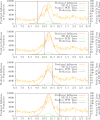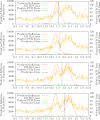A Bayesian system to detect and characterize overlapping outbreaks
- PMID: 28797710
- PMCID: PMC5604259
- DOI: 10.1016/j.jbi.2017.08.003
A Bayesian system to detect and characterize overlapping outbreaks
Abstract
Outbreaks of infectious diseases such as influenza are a significant threat to human health. Because there are different strains of influenza which can cause independent outbreaks, and influenza can affect demographic groups at different rates and times, there is a need to recognize and characterize multiple outbreaks of influenza. This paper describes a Bayesian system that uses data from emergency department patient care reports to create epidemiological models of overlapping outbreaks of influenza. Clinical findings are extracted from patient care reports using natural language processing. These findings are analyzed by a case detection system to create disease likelihoods that are passed to a multiple outbreak detection system. We evaluated the system using real and simulated outbreaks. The results show that this approach can recognize and characterize overlapping outbreaks of influenza. We describe several extensions that appear promising.
Keywords: Bayesian modeling; Influenza; Outbreak characterization; Outbreak detection.
Copyright © 2017 Elsevier Inc. All rights reserved.
Figures








Similar articles
-
A method for detecting and characterizing outbreaks of infectious disease from clinical reports.J Biomed Inform. 2015 Feb;53:15-26. doi: 10.1016/j.jbi.2014.08.011. Epub 2014 Aug 30. J Biomed Inform. 2015. PMID: 25181466 Free PMC article.
-
A Bayesian System to Detect and Track Outbreaks of Influenza-Like Illnesses Including Novel Diseases: Algorithm Development and Validation.JMIR Public Health Surveill. 2024 Aug 13;10:e57349. doi: 10.2196/57349. JMIR Public Health Surveill. 2024. PMID: 38805611 Free PMC article.
-
A Bayesian Outbreak Detection Method for Influenza-Like Illness.Biomed Res Int. 2015;2015:751738. doi: 10.1155/2015/751738. Epub 2015 Sep 6. Biomed Res Int. 2015. PMID: 26425552 Free PMC article.
-
Global Variations in Event-Based Surveillance for Disease Outbreak Detection: Time Series Analysis.JMIR Public Health Surveill. 2022 Oct 31;8(10):e36211. doi: 10.2196/36211. JMIR Public Health Surveill. 2022. PMID: 36315218 Free PMC article.
-
FluHMM: A simple and flexible Bayesian algorithm for sentinel influenza surveillance and outbreak detection.Stat Methods Med Res. 2019 Jun;28(6):1826-1840. doi: 10.1177/0962280218776685. Epub 2018 Jun 5. Stat Methods Med Res. 2019. PMID: 29869565
Cited by
-
Multi-step ahead meningitis case forecasting based on decomposition and multi-objective optimization methods.J Biomed Inform. 2020 Nov;111:103575. doi: 10.1016/j.jbi.2020.103575. Epub 2020 Sep 22. J Biomed Inform. 2020. PMID: 32976990 Free PMC article.
-
Integrating artificial intelligence with mechanistic epidemiological modeling: a scoping review of opportunities and challenges.Nat Commun. 2025 Jan 10;16(1):581. doi: 10.1038/s41467-024-55461-x. Nat Commun. 2025. PMID: 39794317 Free PMC article.
-
Dynamic graph and polynomial chaos based models for contact tracing data analysis and optimal testing prescription.J Biomed Inform. 2021 Oct;122:103901. doi: 10.1016/j.jbi.2021.103901. Epub 2021 Aug 30. J Biomed Inform. 2021. PMID: 34474189 Free PMC article.
References
-
- World Health Organization. Influenza fact sheet. 2003
-
- Wagner Michael, Tsui Fuchiang, Cooper Gregory, Espino Jeremy, Harkema Hendrik, Levander John, Villamarin Ricardo, Voorhees Ronald, Millett Nicholas, Keane Christopher. Probabilistic, decision-theoretic disease surveillance and control. Online Journal of Public Health Informatics. 2011;3(3) - PMC - PubMed
-
- Tsui Fuchiang, Wagner Michael, Cooper Gregory, Que Jialan, Harkema Hendrik, Dowling John, Sriburadej Thomsun, Li Qi, Espino Jeremy, Voorhees Ronald. Probabilistic case detection for disease surveillance using data in electronic medical records. Online Journal of Public Health Informatics. 2011;3(3) - PMC - PubMed
MeSH terms
Grants and funding
LinkOut - more resources
Full Text Sources
Other Literature Sources
Medical

